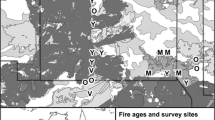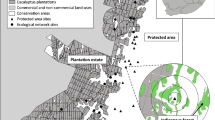Abstract
For South African butterflies that congregate on hill summits, thevegetation type that clothes hills has a major influence on behaviour andspecies assemblages. Congregation of individuals occurred on grass-covered hillsin a grassland matrix, while little congregation occurred on hills covered with undisturbed natural forest, nor on those with closely packed, mixed,plantation trees. Hill-summit congregation was not prevented by smalldifferences in hilltop grassland vegetation type, nor by low densities of thealien plant Eucalyptus grandis. This study demonstrates theimportance of taking into account the interplay of topography, vegetation typeand architecture when planning for conservation.
Similar content being viewed by others
References
Alcock J. 1985. Hilltopping in the nymphalid butterfly Chlosyne californica (Lepidoptera). American Midland Naturalist 113: 69-75.
Alcock J. 1987. Leks and hilltopping in insects. Journal of Natural History 21: 319-328.
Amiet J.-L. and Libert M. 1995. Biodiversité et repartition spatiale des Lépidoptéres Rhopalocéres du mont Bana (Cameroun). Bulletin de la Societé Entomologique de France 100: 221-240.
Baker N. 1994. You do what with butterflies? Butterfly Conservation News58: 18-19.
Baughman J.F. and Murphy D.D. 1988. What constitutes a hill to a hilltopping butterfly? American Midland Naturalist 120: 441-444.
Begon M., Harper J.L. and Townsend C.R. 1993. Ecology: Individuals, Populations and Communities. Blackwell Scientific Publications, Oxford.
Britton D.R., New T.R. and Jelinek A. 1995. Rare Lepidoptera at Mount Piper, Victoria - the role of a threatened butterfly community in advancing understanding of insect conservation. Journal of the Lepidopterist' Society 49: 97-113.
Ehrlich P.R. 1984. The structure and dynamics of butterfly populations. In: Vane-Wright R.I. and Ackery P.R. (eds), Symposium of the Royal Society of London, Number 11, The Biology of Butterflies. Academic Press, London, pp. 25-40.
Field P. 1995. Conservation of Victorian butterflies. Victoria Naturalist 112: 43-46.
Fitzpatrick S.M. and Wellington W.G. 1983. Insect territoriality. Canadian Journal of Zoology 61: 471-486.
Hattingh V. and Samways M.J. 1995. Visual and olfactory location of biotopes, prey patches, and individual prey by the ladybeetle Chilocorus nigritus. Entomologia Experimentalis et Applicata 75: 87-98.
Henning S.F. 1990. Courtship and mating of butterflies. The Entomologist' Record and Journal of Variation 102: 205-213.
James F.C. and Rathbun S. 1981. Rarefaction, relative abundance, and diversity of avian communities. The Auk 98: 785-800.
Jelinek A. 1995. Conservation strategy for a threatened 'butterfly community'. Victoria Naturalist 112: 47-50.
Jelinek A., Britton D.R. and New T.R. 1994. Conservation of a 'threatened butterfly community' at Mount Piper, Victoria. Memoirs of the Queensland Museum 36: 115-120.
Killick D.J.B. 1963. An Account of the Plant Ecology of the Cathedral Peak Area of the Natal Drakensberg. Botanical Survey Memoir No. 34. Botanical Research Institute, Department of Agricultural Services, Pretoria.
Kingsolver J.G. 1985. Butterfly thermoregulation: organismic mechanisms and population consequences. Journal of Research on the Lepidoptera 24: 1-20.
Libert M. 1994. Biodiversité: le peuplement en Rhopalocéres de deux collines de la région de Yaoundé, Cameroun (Lepidoptera). Bulletin de la Societé Entomologique de France 99: 335-355.
Ludwig J.A. and Reynolds J.F. 1988. Statistical Ecology: A Primer on Methods and Computing. Wiley, New York.
Pinheiro C.E.G. 1990. Territorial hilltopping behaviour of three swallowtail butterflies (Lepidoptera, Papilionidae) in western Brazil. Journal of Research on the Lepidoptera 29: 134-142.
Preston-Mafham R. and Preston-Mafham K. 1988. Butterflies of the World. Blandford Press, London.
Rutowski R.L. 1991. The evolution of male mate-locating behaviour in butterflies. American Naturalist 138: 1121-1139.
Samways M.J. 1990. Land forms and winter habitat refugia in the conservation of montane grasshoppers in southern Africa. Conservation Biology 4: 375-382.
Samways M.J. 1994. Insect Conservation Biology. Chapman & Hall, London.
Scott J.A. 1968. Hilltopping as a mating mechanism to aid the survival of low density species. Journal of Research on the Lepidoptera 7: 191-204.
Scott J.A. 1974. Mate-locating behaviour of butterflies. American Midland Naturalist 91: 103-117.
Shields O. 1967. Hilltopping: an ecological study of summit congregation behaviour of butterflies on a southern Californian hill. Journal of Research on the Lepidoptera 6: 69-178.
Thomas J.A. 1983. The ecology and conservation of Lysandra bellargus (Lepidoptera: Lycaenidae) in Britain. Journal of Applied Ecology 20: 59-83.
Thornhill R. and Alcock J. (eds) 1983. The Evolution of Insect Mating Systems. Harvard University Press, Cambridge, Massachusetts.
Van Someren V.G.L. 1955. Butterflies and hilltops in East Africa. Lepidoptera News 9: 127-132.
Warren M.S. 1987a. The ecology and conservation of the heath fritillary butterfly, Mellicta athalia: adult population structure and mobility. Journal of Applied Ecology 24: 483-498.
Warren M.S. 1987b. The ecology and conservation of the heath fritillary butterfly, Mellicta athalia: population dynamics and the effect of habitat management. Journal of Applied Ecology 24: 499-513.
Wickman P.-O. and Wiklund C. 1983. Territorial defence and its seasonal decline in the speckled wood butterfly (Pararge aegeria). Animal Behaviour 31: 1206-1216.
Williams G. 1987. Techniques and Fieldwork in Ecology. Bell & Hyman, London.
Wood P.A. and Samways M.J. 1991. Landscape element patterns and continuity of butterfly flight paths in an ecologically landscaped botanic garden, Natal, South Africa. Biological Conservation 58: 149-166.
Author information
Authors and Affiliations
Rights and permissions
About this article
Cite this article
Lawrence, J.M., Samways, M.J. Influence of hilltop vegetation type on an African butterfly assemblage and its conservation. Biodiversity and Conservation 11, 1163–1171 (2002). https://doi.org/10.1023/A:1016017114473
Issue Date:
DOI: https://doi.org/10.1023/A:1016017114473




